HSBC 2007 Annual Report Download - page 15
Download and view the complete annual report
Please find page 15 of the 2007 HSBC annual report below. You can navigate through the pages in the report by either clicking on the pages listed below, or by using the keyword search tool below to find specific information within the annual report.-
 1
1 -
 2
2 -
 3
3 -
 4
4 -
 5
5 -
 6
6 -
 7
7 -
 8
8 -
 9
9 -
 10
10 -
 11
11 -
 12
12 -
 13
13 -
 14
14 -
 15
15 -
 16
16 -
 17
17 -
 18
18 -
 19
19 -
 20
20 -
 21
21 -
 22
22 -
 23
23 -
 24
24 -
 25
25 -
 26
26 -
 27
27 -
 28
28 -
 29
29 -
 30
30 -
 31
31 -
 32
32 -
 33
33 -
 34
34 -
 35
35 -
 36
36 -
 37
37 -
 38
38 -
 39
39 -
 40
40 -
 41
41 -
 42
42 -
 43
43 -
 44
44 -
 45
45 -
 46
46 -
 47
47 -
 48
48 -
 49
49 -
 50
50 -
 51
51 -
 52
52 -
 53
53 -
 54
54 -
 55
55 -
 56
56 -
 57
57 -
 58
58 -
 59
59 -
 60
60 -
 61
61 -
 62
62 -
 63
63 -
 64
64 -
 65
65 -
 66
66 -
 67
67 -
 68
68 -
 69
69 -
 70
70 -
 71
71 -
 72
72 -
 73
73 -
 74
74 -
 75
75 -
 76
76 -
 77
77 -
 78
78 -
 79
79 -
 80
80 -
 81
81 -
 82
82 -
 83
83 -
 84
84 -
 85
85 -
 86
86 -
 87
87 -
 88
88 -
 89
89 -
 90
90 -
 91
91 -
 92
92 -
 93
93 -
 94
94 -
 95
95 -
 96
96 -
 97
97 -
 98
98 -
 99
99 -
 100
100 -
 101
101 -
 102
102 -
 103
103 -
 104
104 -
 105
105 -
 106
106 -
 107
107 -
 108
108 -
 109
109 -
 110
110 -
 111
111 -
 112
112 -
 113
113 -
 114
114 -
 115
115 -
 116
116 -
 117
117 -
 118
118 -
 119
119 -
 120
120 -
 121
121 -
 122
122 -
 123
123 -
 124
124 -
 125
125 -
 126
126 -
 127
127 -
 128
128 -
 129
129 -
 130
130 -
 131
131 -
 132
132 -
 133
133 -
 134
134 -
 135
135 -
 136
136 -
 137
137 -
 138
138 -
 139
139 -
 140
140 -
 141
141 -
 142
142 -
 143
143 -
 144
144 -
 145
145 -
 146
146 -
 147
147 -
 148
148 -
 149
149 -
 150
150 -
 151
151 -
 152
152 -
 153
153 -
 154
154 -
 155
155 -
 156
156 -
 157
157 -
 158
158 -
 159
159 -
 160
160 -
 161
161 -
 162
162 -
 163
163 -
 164
164 -
 165
165 -
 166
166 -
 167
167 -
 168
168 -
 169
169 -
 170
170 -
 171
171 -
 172
172 -
 173
173 -
 174
174 -
 175
175 -
 176
176 -
 177
177 -
 178
178 -
 179
179 -
 180
180 -
 181
181 -
 182
182 -
 183
183 -
 184
184 -
 185
185 -
 186
186 -
 187
187 -
 188
188 -
 189
189 -
 190
190 -
 191
191 -
 192
192 -
 193
193 -
 194
194 -
 195
195 -
 196
196 -
 197
197 -
 198
198 -
 199
199 -
 200
200 -
 201
201 -
 202
202 -
 203
203 -
 204
204 -
 205
205 -
 206
206 -
 207
207 -
 208
208 -
 209
209 -
 210
210 -
 211
211 -
 212
212 -
 213
213 -
 214
214 -
 215
215 -
 216
216 -
 217
217 -
 218
218 -
 219
219 -
 220
220 -
 221
221 -
 222
222 -
 223
223 -
 224
224 -
 225
225 -
 226
226 -
 227
227 -
 228
228 -
 229
229 -
 230
230 -
 231
231 -
 232
232 -
 233
233 -
 234
234 -
 235
235 -
 236
236 -
 237
237 -
 238
238 -
 239
239 -
 240
240 -
 241
241 -
 242
242 -
 243
243 -
 244
244 -
 245
245 -
 246
246 -
 247
247 -
 248
248 -
 249
249 -
 250
250 -
 251
251 -
 252
252 -
 253
253 -
 254
254 -
 255
255 -
 256
256 -
 257
257 -
 258
258 -
 259
259 -
 260
260 -
 261
261 -
 262
262 -
 263
263 -
 264
264 -
 265
265 -
 266
266 -
 267
267 -
 268
268 -
 269
269 -
 270
270 -
 271
271 -
 272
272 -
 273
273 -
 274
274 -
 275
275 -
 276
276 -
 277
277 -
 278
278 -
 279
279 -
 280
280 -
 281
281 -
 282
282 -
 283
283 -
 284
284 -
 285
285 -
 286
286 -
 287
287 -
 288
288 -
 289
289 -
 290
290 -
 291
291 -
 292
292 -
 293
293 -
 294
294 -
 295
295 -
 296
296 -
 297
297 -
 298
298 -
 299
299 -
 300
300 -
 301
301 -
 302
302 -
 303
303 -
 304
304 -
 305
305 -
 306
306 -
 307
307 -
 308
308 -
 309
309 -
 310
310 -
 311
311 -
 312
312 -
 313
313 -
 314
314 -
 315
315 -
 316
316 -
 317
317 -
 318
318 -
 319
319 -
 320
320 -
 321
321 -
 322
322 -
 323
323 -
 324
324 -
 325
325 -
 326
326 -
 327
327 -
 328
328 -
 329
329 -
 330
330 -
 331
331 -
 332
332 -
 333
333 -
 334
334 -
 335
335 -
 336
336 -
 337
337 -
 338
338 -
 339
339 -
 340
340 -
 341
341 -
 342
342 -
 343
343 -
 344
344 -
 345
345 -
 346
346 -
 347
347 -
 348
348 -
 349
349 -
 350
350 -
 351
351 -
 352
352 -
 353
353 -
 354
354 -
 355
355 -
 356
356 -
 357
357 -
 358
358 -
 359
359 -
 360
360 -
 361
361 -
 362
362 -
 363
363 -
 364
364 -
 365
365 -
 366
366 -
 367
367 -
 368
368 -
 369
369 -
 370
370 -
 371
371 -
 372
372 -
 373
373 -
 374
374 -
 375
375 -
 376
376 -
 377
377 -
 378
378 -
 379
379 -
 380
380 -
 381
381 -
 382
382 -
 383
383 -
 384
384 -
 385
385 -
 386
386 -
 387
387 -
 388
388 -
 389
389 -
 390
390 -
 391
391 -
 392
392 -
 393
393 -
 394
394 -
 395
395 -
 396
396 -
 397
397 -
 398
398 -
 399
399 -
 400
400 -
 401
401 -
 402
402 -
 403
403 -
 404
404 -
 405
405 -
 406
406 -
 407
407 -
 408
408 -
 409
409 -
 410
410 -
 411
411 -
 412
412 -
 413
413 -
 414
414 -
 415
415 -
 416
416 -
 417
417 -
 418
418 -
 419
419 -
 420
420 -
 421
421 -
 422
422 -
 423
423 -
 424
424 -
 425
425 -
 426
426 -
 427
427 -
 428
428 -
 429
429 -
 430
430 -
 431
431 -
 432
432 -
 433
433 -
 434
434 -
 435
435 -
 436
436 -
 437
437 -
 438
438 -
 439
439 -
 440
440 -
 441
441 -
 442
442 -
 443
443 -
 444
444 -
 445
445 -
 446
446 -
 447
447 -
 448
448 -
 449
449 -
 450
450 -
 451
451 -
 452
452 -
 453
453 -
 454
454 -
 455
455 -
 456
456 -
 457
457 -
 458
458 -
 459
459 -
 460
460 -
 461
461 -
 462
462 -
 463
463 -
 464
464 -
 465
465 -
 466
466 -
 467
467 -
 468
468 -
 469
469 -
 470
470 -
 471
471 -
 472
472 -
 473
473 -
 474
474 -
 475
475 -
 476
476
 |
 |
13
In calculating TSR, dividend income is assumed to
be invested in the underlying shares. As the
comparator group includes companies listed on
overseas markets, a common currency is used to
ensure that TSR is measured on a consistent basis.
The TSR benchmark is an index set at 100 and
measured over one, three and five years for the
purpose of comparison with the performance of a
group of competitor banks which reflect HSBC’s
range and breadth of activities. The TSR levels at the
end of 2007 were 95.6, 111.3, and 158.8 over one,
three and five years respectively. HSBC’s TSR over
all above mentioned periods has underperformed the
benchmark. This is attributed largely to the impact
on the share price of the current weakness in the US
sub-prime mortgage business and investor
preference over this time for companies with smaller
market values, particularly those for which there is
the possibility of participating in domestic or
regional consolidation.
Management believes that financial KPIs must
remain relevant to the business so they may be
changed over time to reflect changes in the Group’s
composition and the strategies employed.
Non-financial KPIs
HSBC has chosen four non-financial KPIs which are
important to the future success of the Group in
delivering its strategic objectives. These non-
financial KPIs are currently reported internally
within HSBC on a local basis.
Employee engagement
Employee engagement is a measure of employees’
emotional and rational attachment to HSBC.
In 2007, HSBC conducted its first Global
People Survey. This comprised questions designed to
measure employee engagement levels consistently
across the Group. The survey covers HSBC’s entire
permanent global workforce, and responses were
received from almost 290,000 employees, a response
rate of 88 per cent.
The overall employee engagement index score
was 60 per cent. The 2008 target is 62 per cent.
Survey questions were grouped into twelve
dimensions. Employees rated HSBC above the
external global norms in all these dimensions. In two
dimensions, reputation and corporate responsibility,
employees rated HSBC as achieving the external
best in class norm. The survey results have been
shared with all employees and action plans are being
developed at all levels of the organisation.
Brand perception
The score for brand perception is set by data
from surveys that are conducted by accredited,
independent, third party organisations. A weighted
score card is used to produce an overall score on a
100 point scale which is then benchmarked against
HSBC's main competitors. The scores from each
market are weighted according to the risk adjusted
revenues earned in that market to obtain the overall
company score.
The 2007 brand scores for Personal Financial
Services and Commercial Banking were ahead of the
competitor averages by 6 and 7 points, respectively,
on a 100 point scale. The 2008 brand perception
target is to increase the gap to 9 points and 8 points,
respectively.
Customer satisfaction
HSBC has regularly conducted customer satisfaction
surveys in its main markets over many years. HSBC
now uses a consistent measure of customer
recommendation to gauge customer satisfaction with
the services provided by the Group's Personal
Financial Services business. This survey is also
conducted by accredited, independent, third party
organisations and the resulting recommendation
scores are benchmarked against competitors.
The 2007 customer recommendation score for
Personal Financial Services was ahead of the
competitor average by 1 point on a 100 point scale.
The 2008 target is to increase that gap to 2.5 points.
IT performance and systems reliability
HSBC tracks two key measures as indicators of IT
performance; namely, the number of customer
transactions processed and the reliability and
resilience of systems measured in terms of service
availability targets.
Number of customer transactions processed
The number of customer transactions processed is a
reflection of the increasing usage of IT in each of the
delivery channels used to service customers. Its aim
is to manage the rate of increase in customer
transaction costs effectively and ensure that
customer growth is enabled in the appropriate
channels. The transition of customer transactions
from labour intensive (branch, call centre and others)
to automated (credit card, internet, self-service and
other e-channels) is occurring. The following chart
shows the 2005, 2006 and 2007 volumes per
delivery channel:
